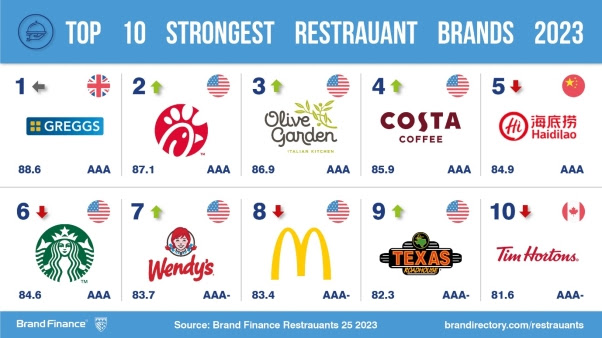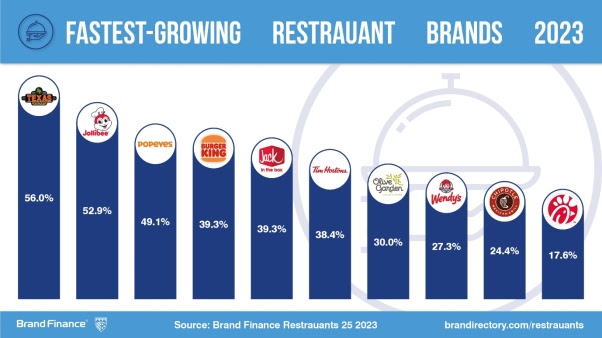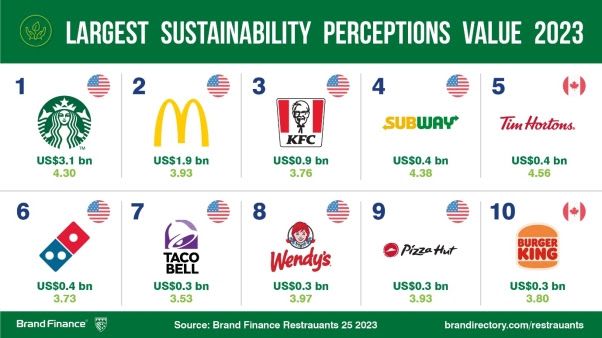Starbucks extends lead, remaining most valuable restaurant brand for 7th consecutive year, widening gap on McDonald’s. Starbucks (brand value up 17% to USD53.4 billion) has cemented its position as the world’s most valuable restaurant brand. The American multinational coffeehouse chain has held this position for seven consecutive years and has significantly widened its lead over the second most valuable restaurants brand, McDonald’s (brand value down 7% to USD36.9 billion).
Every year, leading brand valuation consultancy Brand Finance puts 5,000 of the biggest brands to the test, and publishes over 100 reports, ranking brands across all sectors and countries. The world’s top 25 most valuable and strongest brands in the Restaurant brands are included in the annual Brand Finance Restaurant 25 2023 ranking.

Richard Haigh, Managing Director of Brand Finance commented: “Restaurant brands have faced continued challenges throughout the last few years, from the Covid-19 pandemic induced lockdowns, to rising inflation and supply chain issues. Despite this, some of the world’s largest restaurant brands, such as Starbucks, have successfully navigated these difficulties to achieve solid brand value growth. In order to sustain success going forward, restaurant brands must increasingly cater to the higher standards for sustainability that consumers are demanding when it comes to the food they eat and drink.”

Texas Roadhouse is the fastest growing brand, up 56%, Jollibee follow close behind
Texas Roadhouse has achieved a 56% brand value increase in 2023, to a brand value of US$2.3 billion, making it the fastest growing restaurant brand in the ranking. This brand value increase comes primarily as a result of the brand’s strong expansion strategy. The brand now operates 700 restaurants and has further raised its expansion targets for the coming years, hoping to reach 900 units.
Filipino brand Jollibee (brand value up 53% to USD1.6 billion) followed closely behind as the second fastest growing brand in the ranking. The brand’s post-pandemic growth plans have seen it expand further into the US market, planning to open 500 stores in the coming years and rival other fast-food giants such as McDonald’s and KFC.

Greggs is the strongest brand in the restaurant sector with AAA rating
In addition to calculating brand value, Brand Finance also determines the relative strength of brands through a balanced scorecard of metrics evaluating marketing investment, stakeholder equity, and business performance. Compliant with ISO 20671, Brand Finance’s assessment of stakeholder equity incorporates original market research data from over 150,000 respondents in 38 countries and across 31 sectors.
British baked goods institution, Greggs (brand value up 17% to US$1 billion), is the strongest brand in the ranking with a Brand Strength Index Score of 89/100 and corresponding AAA rating. Greggs remains the strongest brand despite raising the prices of its products in the face of rising operating cost, inflation, and supply chain issues.

Starbucks has highest Sustainability Perceptions Value of USD3.1 billion
As part of its analysis, Brand Finance assesses the role that specific brand attributes play in driving overall brand value. One such attribute, growing rapidly in its significance, is sustainability. Brand Finance assesses how sustainable specific brands are perceived to be, represented by a ‘Sustainability Perceptions Score’. The value that is linked to sustainability perceptions, the ‘Sustainability Perceptions Value’, is then calculated for each brand.
As well as being the world’s most valuable restaurant brand, Starbucks also has the highest Sustainability Perception Value of US$3.1 billion. The brand’s position at the top of the Sustainability Perceptions Value table is not an assessment of its overall sustainability performance, but rather indicates how much brand value the brand has tied up in sustainability perceptions.



 share
share










































